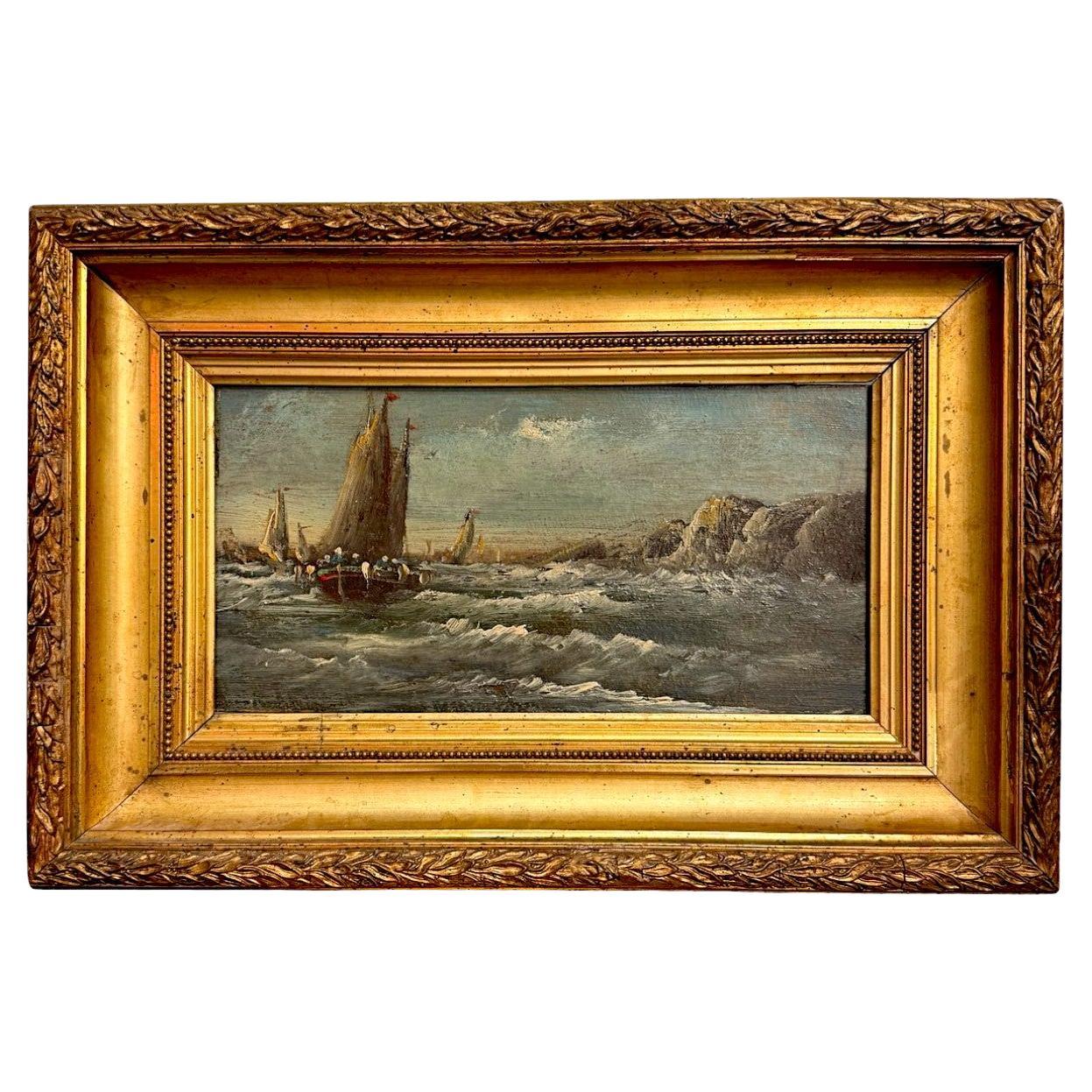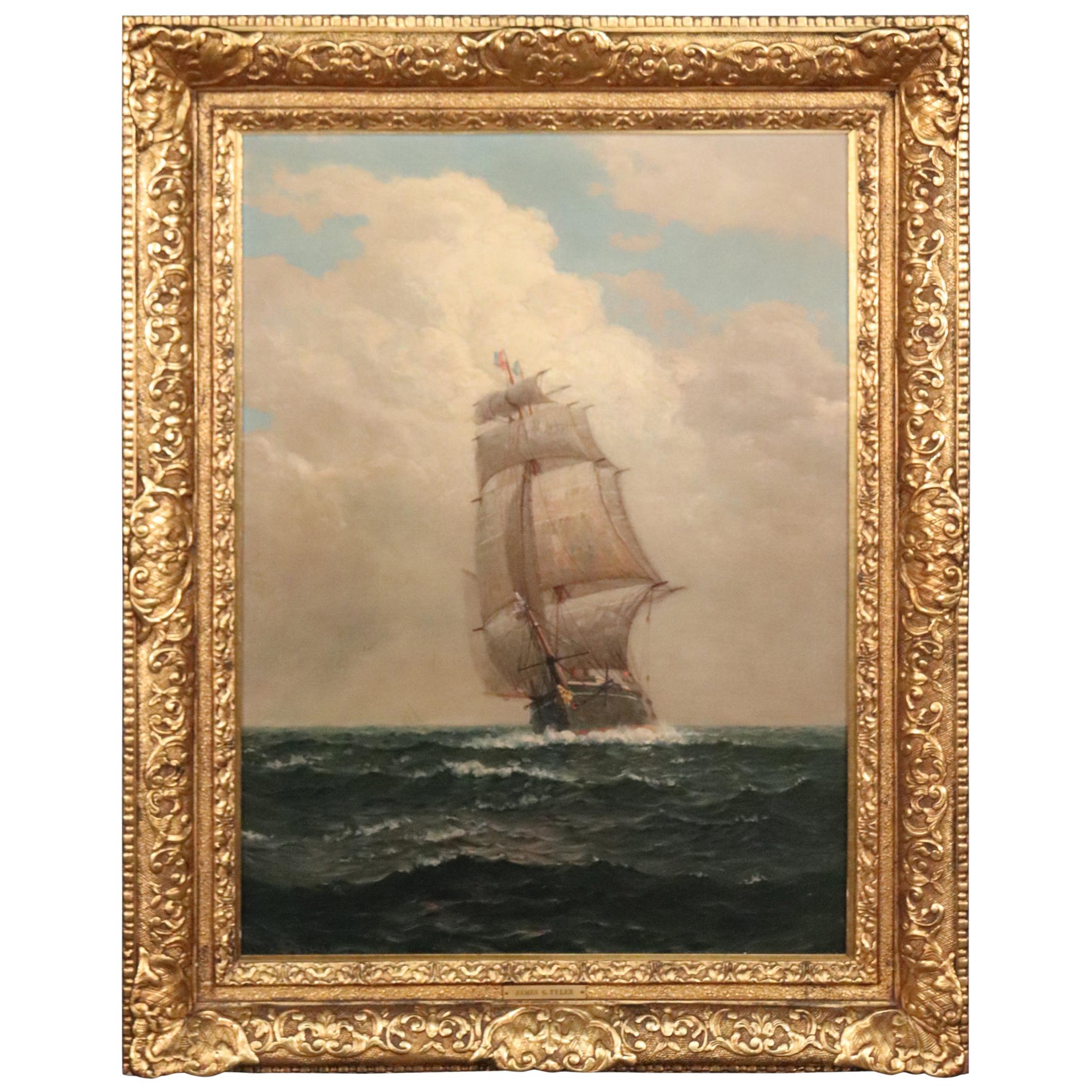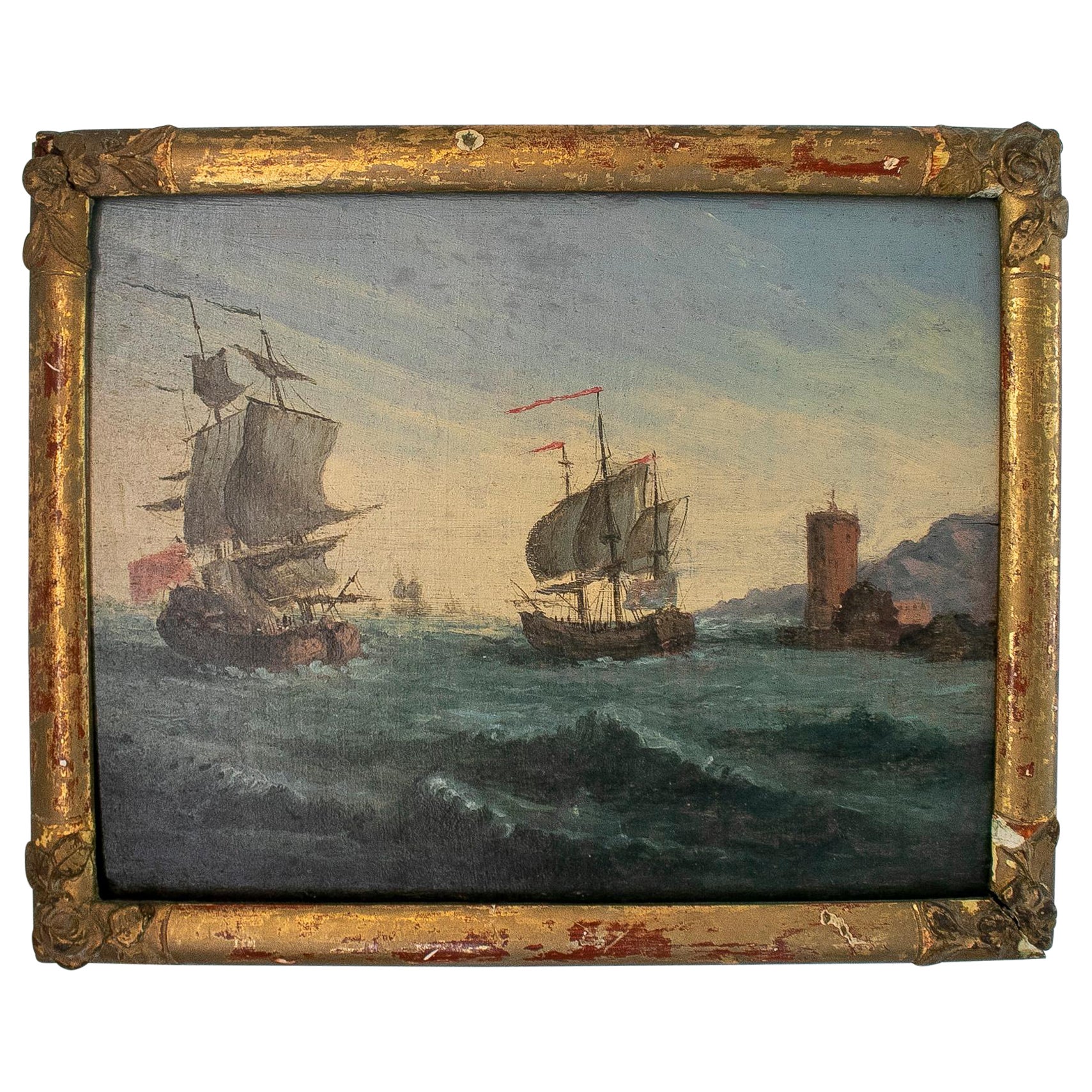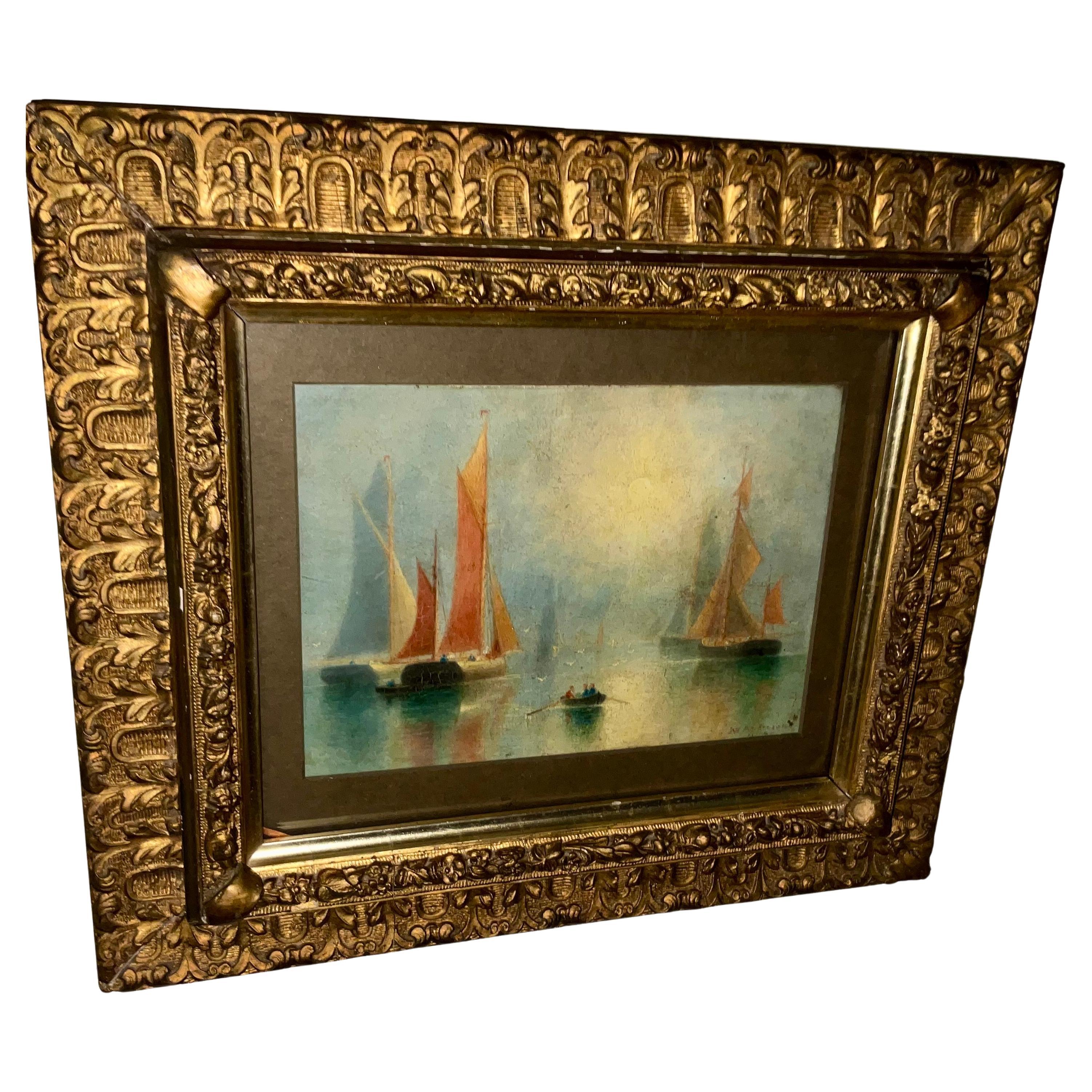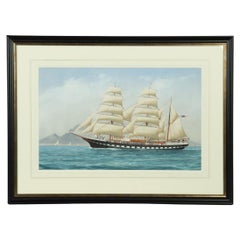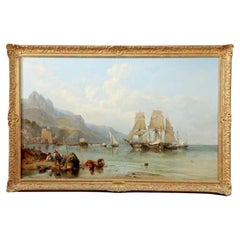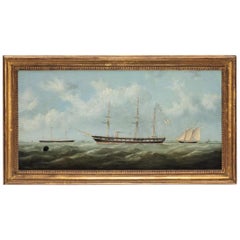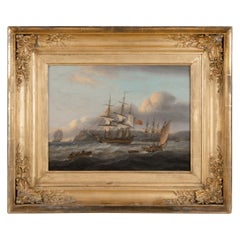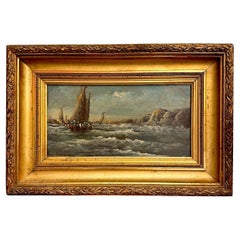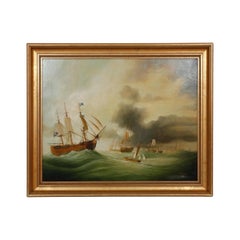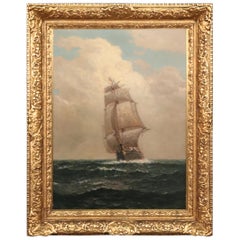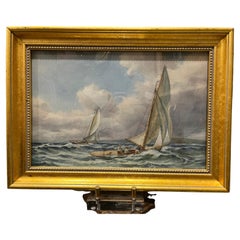Items Similar to An oil on canvas of William Paget, Marquess of Anglesey’s yacht Pearl by Nicolas
Want more images or videos?
Request additional images or videos from the seller
1 of 8
An oil on canvas of William Paget, Marquess of Anglesey’s yacht Pearl by Nicolas
$29,035.25
£21,000
€24,763.15
CA$40,194.71
A$43,582.84
CHF 23,128.90
MX$536,778.07
NOK 286,668.12
SEK 270,548.79
DKK 184,838.25
About the Item
An oil on canvas of William Paget, Marquess of Anglesey’s yacht Pearl by Nicolas Condy, the reverse with a paper trade label for ‘Akermann & Co, prepared millboards, pastels, canvass and *bladder colours, Repository of Arts 96, Strand, London’, in the original ornate gilt frame. English, circa 1842.
Provenance: Almost certainly commissioned by Henry William Paget, 1st Marquess of Anglesey (1768-1854)
References: The painting appears in several Paget family inventories, showing that it was hanging at their Staffordshire seat Beaudesert in 1863.
Anon, Beaudesert / 1863 / Inventory, p. 107, in ‘My Lord’s Bedroom’, (Staffordshire Record Office, D603/7/4);
and then, since at least 1910, in the private apartments at Plas Newydd
Thomas Agnew & Son, London, Valuation for Insurance of The Pictures and Drawings, The Property of the Most Honourable The Marquess of Anglesey, At Uxbridge House, St James Square, Plas Newydd, and 8 Lees Mews, 2 February 1910, at Plas Neywdd, probably no. 29, (as Painting of a Yacht (The Pearl), N M Condy) (Bangor University Archives and Special Collections, PN/IX/3198).
The Pearl and her Significance:
Built in Colchester in 1820 and launched the following year, The Marquess of Anglesey’s Pearl was
the dominant yacht in the early days of racing and the Royal Yacht Squadron. In ‘The Royal Yacht
Squadron; memorials of its members, with an enquiry into the history of yachting and the its
development in the Solent’, Montague Guest and William B. Boulton, 1902, the authors
wrote ‘Lord Anglesey in the possession of the Pearl was for many years secure against the rivalry of
the others who depended upon vessels of much smaller tonnage, and she remained unbeaten as long as her owner sailed her in the few matches of the early days’. They also remarked that the
vessel was ‘an exceptional boat of 113 tons….and her lines were taken in to account in after years by
most of the crack builders of the southern ports’. The Marquess took full advantage of the fact that Pearl was one of only two yachts of more than 100 tons at this time. In 1832 she was in Naples being refitted as a cruising vessel for the Mediterranean and the Caribbean however she retained her position of prominence in the racing world and would frequently act as ceremonial starter for regattas etc. In 1843 the Marquess was elected to membership of the Royal Thames Yacht Club as well, intriguingly on the very same day that N. M. Condy was appointed official painter to the Club.
Images of Pearl appear in the aforementioned history of the Royal Yacht Squadron.
The Marquess of Anglesey and his Part in Yachting History
Aside from his great military heroism (Paget famously lost a leg at Waterloo and was rewarded with his title and then, three years later, the Order of the Garter), the Marquess is a highly significant figure in yachting circles. He was one of the founder members, in 1815, of what would later become the Royal Yacht Squadron. He was also the owner of Cowes Castle, later to become the Squadron’s clubhouse. Perhaps his lasting fame in sailing circles was most established by the fact that he was the man who presented the trophy which would later become the Americas Cup. He gave the trophy to the Squadron for use as a prize, with no particular conditions attached, in 1848 or thereabouts but in 1851 the Squadron decided to use the trophy for its newly established “All Nations” race, later to be renamed the America’s Cup in 1857.
Nicholas Matthew Condy (1818-1851)
The son of a landscape painter, Condy was originally planning a career in the military but discovered, for himself, the joys of painting. He attended the Mount Radford School in Exeter before studying painting under the Rev. C. Thomas.
He exhibited at the Royal Academy three times in the 1840s and was patronised by the Earl of Egremont, Turner’s most prominent patron, amongst other early supporters. An article in Bell’s Life in London and Sporting Chronicle, 10th September 1843, records that Condy was ‘elected marine painter to the (Royal Thames Yacht) Club. Mr Condy has recently executed portraits of the Gnome and Phantom. The former was exhibited to the club on Thursday – she is lying to, and the whole picture reflects great credit on Mr Condy’s nautical knowledge and skill as an artist. It was painted whilst Mr Meeson was at Cowes with his yacht, and we understand that it was particularly admired by the members of the Royal Yacht Squadron, and a succession of orders was the consequence’.
Condy was based for most of his life in Plymouth, the setting for this picture, and an article in the Exeter and Plymouth Gazette, dated 30th September 1843, describes a forthcoming exhibition of works by Devon artists including four views by Condy depicting aspects of Queen Victoria’s recent visit by sea to Plymouth. The scenes were later issued as lithographs.
An advert placed in Bell’s Life in London and Sporting Chronicle, 9th of June 1850, reveals that Condy had painted the Pearl on more than one occasion. It states that one of a series of scenes about to be issued as prints was ‘The Kestrel R.Y.S., the property of the late Earl of Yarborough, under weigh in the Cowes roads, in company with the Pearl, Camilla, Xarifa and the Flirt’.
Condy died suddenly in 1851 at a tragically early age. His obituary, published in the Morning Advertiser on 24th May of that year stated ‘His power of delineating shipping and all their material, has seldom been surpassed; every ship, however minute, was recognised at once by the sailor as a perfect likeness, and few artists enjoyed such royal and noble patronage‘. This painting is a fine example of the work of this talented painter.
*Pigs’ bladders were used for centuries, before the invention of the paint tube in 1841, to store their paints.
- Dimensions:Height: 30.5 in (77.47 cm)Width: 36 in (91.44 cm)Depth: 5 in (12.7 cm)
- Materials and Techniques:
- Place of Origin:
- Period:
- Date of Manufacture:Circa 1842
- Condition:Wear consistent with age and use.
- Seller Location:Lymington, GB
- Reference Number:1stDibs: LU973041220332
About the Seller
5.0
Recognized Seller
These prestigious sellers are industry leaders and represent the highest echelon for item quality and design.
Gold Seller
Premium sellers maintaining a 4.3+ rating and 24-hour response times
Established in 1982
1stDibs seller since 2013
134 sales on 1stDibs
Typical response time: 2 hours
Associations
LAPADA - The Association of Arts & Antiques Dealers
- ShippingRetrieving quote...Shipping from: Lymington, United Kingdom
- Return Policy
Authenticity Guarantee
In the unlikely event there’s an issue with an item’s authenticity, contact us within 1 year for a full refund. DetailsMoney-Back Guarantee
If your item is not as described, is damaged in transit, or does not arrive, contact us within 7 days for a full refund. Details24-Hour Cancellation
You have a 24-hour grace period in which to reconsider your purchase, with no questions asked.Vetted Professional Sellers
Our world-class sellers must adhere to strict standards for service and quality, maintaining the integrity of our listings.Price-Match Guarantee
If you find that a seller listed the same item for a lower price elsewhere, we’ll match it.Trusted Global Delivery
Our best-in-class carrier network provides specialized shipping options worldwide, including custom delivery.More From This Seller
View AllA Luca Papaluca gouache painting of Royal Yacht Squadron yacht ‘MY Fantôme II, R
Located in Lymington, Hampshire
A Luca Papaluca gouache painting of Royal Yacht Squadron yacht ‘MY Fantôme II, RYS’, the three masted steam sailing barque. Italian, circa in 1920.
Provenance: Sir Arthur Guinness...
Category
Early 20th Century Italian Paintings
Materials
Paint
Clarkson Stanfield: The Gulf of Salerno
Located in Lymington, Hampshire
Clarkson Stanfield: The Gulf of Salerno
This oil painting on canvas shows commercial shipping and fishermen in the Gulf of Salerno. The tower at Vietri is visible in the background...
Category
Antique Mid-19th Century English Paintings
Materials
Canvas, Paint
H.M.S. Topaze by George Mears
Located in Lymington, Hampshire
H.M.S. Topaze by George Mears, the three-masted frigate shown under steam with Royal Yacht Victoria and Albert II in the background on her bow, oil on can...
Category
Antique 19th Century British Paintings
Materials
Paint
Thomas Luny, Hms Bellerophon Leaving Torbay with the Defeated Emperor Napoleon
Located in Lymington, Hampshire
Thomas Luny (British, 1759-1837) HMS Bellerophon leaving Torbay with the defeated Emperor Napoleon aboard, 26th July 1815, this oil on panel shows the crew manning the yards to bring in the sails, having just dropped anchor in Torbay, with another battleship anchored astern and a further ship under sail in the distance, the foreground with working boats approaching, signed and dated ‘Luny 1827’(lower left). In the original gilt-wood frame.
Provenance: Private collection, UK.
Footnote: Despite a service career as illustrious as any fighting ship...
Category
Antique 19th Century British Paintings
Materials
Paint
A small oil painting of a fishing boat leaving Calais Harbour by E W Cooke
By Edward William Cooke
Located in Lymington, Hampshire
A rediscovered small oil painting of a fishing boat leaving Calais Harbour by E W Cooke, depicting a fishing boat from Trouville battling stormy seas as it a...
Category
Antique 1810s English Paintings
Materials
Paint
Thomas Whitcombe ‘Flora’
Located in Lymington, Hampshire
Thomas Whitcombe: ‘Flora’, this oil on canvas shows the action, within a gilt frame with a panel reading ‘British Frigate “Flora”, 36 guns commanded b...
Category
Antique 1780s English Paintings
Materials
Canvas, Paint
$25,924
You May Also Like
Antique Marine Oil Painting in Giltwood Frame, 19th Century
Located in NICE, FR
A dynamic 19th-century French marine oil painting depicting traditional fishing boats returning to shore through choppy coastal waters. This evocative seascape, likely painted along ...
Category
Antique Late 19th Century French Napoleon III Paintings
Materials
Canvas
J. V. Capua Signed Original Oil on Canvas “Lord Cornwallis Signals Make Sail”
Located in Bradenton, FL
A framed oil on canvas by listed British artist J V Capua (b. 1949). The scene depicts the channel fleet, consisting of frigates, gunbrigs, sloops and gunboats on slightly rough seas...
Category
Late 20th Century British Paintings
Materials
Canvas, Wood, Paint
Fine Signed Painting of a Tall Sailing Ship James Gale Tyler
By James Gale Tyler
Located in Swedesboro, NJ
This exceptional maritime oil painting, signed by renowned American artist James Gale Tyler (1855–1931), beautifully captures the majesty of a tall sailing ship navigating through deep ocean waters. Tyler, celebrated for his vivid depictions of seascapes and nautical life, brings the composition to life with dynamic brushwork, dramatic skies, and a commanding ship in full sail. The churning waves and towering vessel reflect his mastery of light, texture, and atmosphere, making this painting a quintessential example of American marine art from the late 19th to early 20th century.
Housed in an ornate gilt frame, the painting exudes grandeur and elegance, ideal for collectors of nautical antiques, maritime art, and historic American paintings...
Category
Antique 1890s American American Classical Paintings
Materials
Canvas, Fruitwood
19th Century Painting of a Yacht Race
Located in Scottsdale, AZ
19th Century Painting of a Yacht Race, Beautiful piece purchased in France. Age appropriate wear, see detailed photos or message us with questions.
Category
Antique 19th Century French American Classical Paintings
Materials
Giltwood, Paint
19th Century English Oil on Canvas Marina Painting w/ Giltwood Frame
Located in Marbella, ES
Antique 19th century English oil on canvas marina painting with giltwood frame
Frame measurements: 29 x 24 x 1,5cm.
Category
Mid-20th Century English Paintings
Materials
Canvas, Paint
Captain J.W. Anderson (fl.1842-1869) Oil on Board 19th c
Located in West Palm Beach, US
Captain J.W. Anderson (fl.1842-1869) Oil on Board Captain J.W. Anderson (1842-1869) Oil on Board
"Setting Sail from Plymouth"
**Artist Biography:**
J. W. (Captain) Anderson was an E...
Category
Antique 1840s British Romantic Paintings
Materials
Wood, Paint
More Ways To Browse
Cowes Yacht
Order Of The Garter
Royal Yacht Squadron
Americas Cup Trophy
Sculpture Teapot
Shutter Doors
Stone Marker
Stone Medallion
Tribal Totem
Victorian Egg
Victorian Oval Frame
Vintage Antique Bamboo
Vintage Blue Angels
Vintage Bride And Groom
Vintage Bull Horns
Vintage Ceramic Containers
Vintage Circus Tent
Vintage Match Holders
